Patient-Centered Strategies for Clinical Trials & Treatment
Pharmaceutical Executive
Pharm Exec and inVentiv Health convened a roundtable discussion at the 2016 ASCO meeting to review the use of patient-reported outcomes (PRO) in the clinical trial and commercialization space.
In the following Roundtable discussion, Pharm Exec and co-host inVentiv Health probe a central question in drug treatment today: what is the appropriate role of the patient-reported outcome (PRO) measure in driving the future of a drug evaluation model that incorporates insights on the real-life patient experience? With payers expressing ambivalence about the PRO as a decision-making tool, particularly in costly, hard-to-treat cancers, the onus is on regulators, industry and the patient to make the case for the PRO through greater methodological clarity and better alignment with other data assessment approaches like patient registries.
Photo: Yancey Hughes

William Looney: We are convening at the annual meeting of the American Society of Clinical Oncology (ASCO), whose theme for 2016 is “collective wisdom”-with the patient as the fulcrum of that wisdom. As a practical

matter, the 32,000 delegates here in Chicago want to know how to leverage this theme to support strategies and guidelines to benefit patients in the clinical setting. Better information on the patient’s actual experience in drug trials and treatment is an obvious place to start. One promising-and underutilized-tool is the patient-reported outcome (PRO), which is now getting close attention at ASCO as well as from the FDA and industry, payers and patient advocates. Where do we stand on the PRO as a measure of progress in making cancer care and research more “patient centric?”
Dr. Joe O’Connell, inVentiv Health: Historically, the attention given to the PRO in clinical drug development has been patchy and inconsistent. It is ironic that we see this in cancer, where symptoms beyond the outcome of the disease itself-pain, fever, fatigue, and loss of weight, among others -have a disproportionate impact on the patient experience. Toxicity of drug therapies is a factor, too. Why PRO measures have yet to take off in clinical practice can be attributed to the following: physician paternalism; lack of interoperability in data systems; regulatory conservatism, as evidenced by the low take up of PROs to support labeling claims; and payer resistance, reinforced by the fact that many older medicines just did not work very well in patients.
Nevertheless, the interest of the clinical community has reached a critical mass. In January, three of the more influential medical journals in the cancer space-The New England Journal of Medicine, JAMA Oncology and ASCO’s own Journal of Clinical Oncology-published separate editorials examining the controversies in using PROs in the development of cancer medicines.
Given the enhanced interest, we see two trends pointing to increased potential for use of PROs. The first is the number of new biologic medicines that target cancer cells more specifically, with spectacular results in many cases, making it easier for PROs to document the positive experience for patients. The second is the growing reliance of payers on health economics assessment to justify their actions on patient reimbursement. There is clearly a place for PRO evidence in that process, which is now arguably more important than obtaining FDA approval. Without support from payers, you can have a great drug but no access to the market.
New survey results
Looney: What payers really think about patient-reported data is still a top-of-mind issue in drug development. Is PRO input seen as useful and relevant-and, if not, why? As a contribution to today’s discussion, inVentiv Health has conducted new survey research with 15 US-based payer representatives-covering both the medical affairs and pharmacy director functions-to dig deeper on their perspective. What are the main conclusions from this work?
Kelly White, inVentiv Health: The aim of our research was twofold. First, we examined how payers currently apply PROs in practice as well as the strategy they intend to follow regarding their use in the future. Second, we asked payers about the role of patient advocates in shaping the evidence requirements to secure drug approvals as well as on access and reimbursement. We tested these ideas with a mix of managed care and integrated delivery network (IDN) organizations that collectively represent 94 million covered lives-approximately a third of the US insured population. All of our interviewees were members of their organization’s P&T committees, with responsibility for the evaluation of oncology medicines for use in the patient setting.
While most of the survey group expressed familiarity with PRO measures, they were considered only “slightly to somewhat influential” in their decision-making on oncology products. Pharmacy directors were more supportive of the contributions of PRO data than the medical directors, a trend that showed up throughout the survey. Yet, on one fundamental metric, there was broad consensus-two-thirds of the entire group surveyed agree that PRO data is most useful at the post-market approval phase, in the real world of clinical practice. There was also a consensus that PRO data outside the product label won’t carry as much influence on decisions to include a product in an oncology treatment pathway. The position reinforces the importance attached by biopharma companies to incorporating PRO data in the labeling process.
We also conducted a qualitative evaluation of comments from the directors we interviewed. There was an evident split between those who view PRO data as “emotional,” “subjective,” and lacking “hard metrics,” and those who support
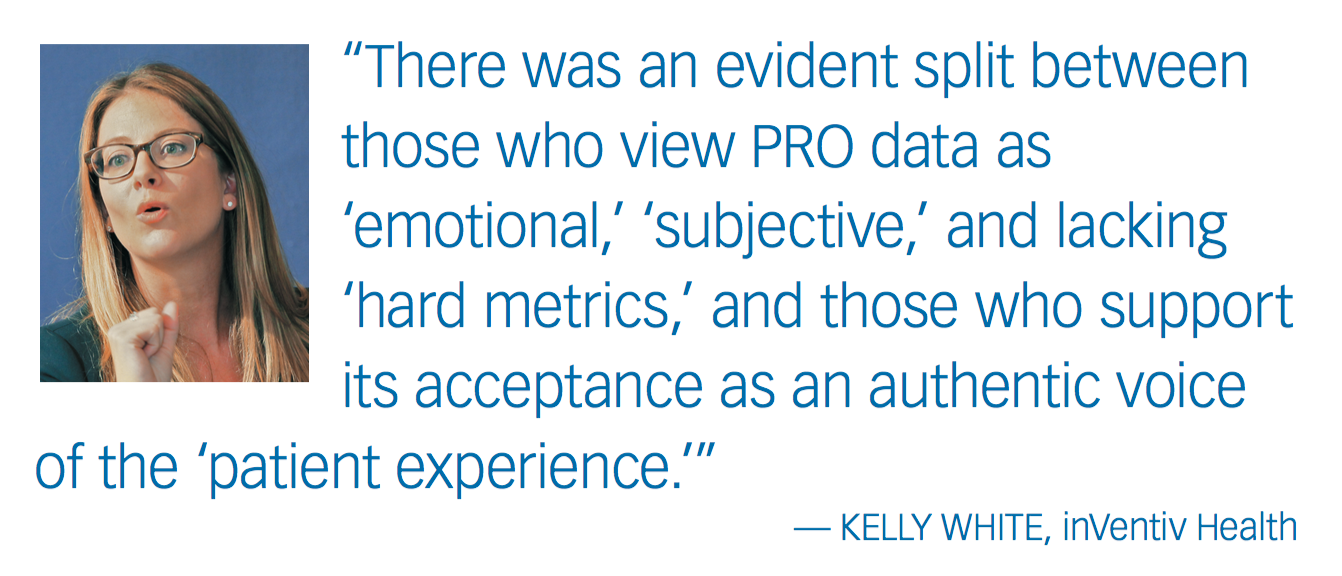
its acceptance as an authentic voice of the “patient experience.” However, on reflection, we hypothesize that both sides were actually saying the same thing: PRO data could indeed be clinically relevant to a product evaluation, but for that to happen, the data must be better structured, uniformly, in a way that is both “scientifically balanced” and “verifiable.” The palpable reaction is disappointment on how current methodology for incorporating PRO data sows confusion on what can actually be measured-and whether such measures are reliable or not.
Kim Metcalf, Kite Pharma: One factor that might explain the difference in attitudes about PRO data between medical and pharmacy directors is the manner in which they approach drug reimbursement. Medical directors tend to focus more on physician administered, in-hospital drugs while the pharmacy director leans to managing medications on an outpatient basis. PRO input will influence how these two roles are incentivized and rewarded; pharmacy directors are directly accountable for the budget impact of every prescription written, while for medical directors, steeped in the outcomes-driven world, the bottom-line impact of prescribing is indirect. It is to be expected that pharmacy directors will be more willing to consider additional types of evidence beyond a randomized controlled trial (RCT) endpoint.
Robert Millham, inVentiv Health: On a therapeutic level, the bar to using PRO data in oncology is always going to be higher because at first examination the evaluation of evidence for benefit appears very cut and dried: did the tumor grow or shrink, what other organs vital to sustaining quality of life were impacted and how did this manifest in symptoms or side effects? It’s the rigor imposed by the experience of fighting cancer that drives attitudes toward what evidence is going to be helpful or not in assessing overall clinical benefit versus baseline standards like the progression-free survival rate.
Metrics test
Krishnan Ramaswamy, Pfizer: Statements in the survey contending that PROs are purely subjective and “rife with bias” are concerning to me. This suggests to me that we clinicians building the evidence base in cancer trials and treatment have to do a better job in educating payers about the progress being made in patient centered outcomes. The science of psychometrics is an attempt to be able to pick up subjective signals in a reliable and valid way, and tremendous progress has been made in all aspects. The December 2009 FDA Guidance on PRO to Support Labeling Claims has spurred efforts to scale up oncology data in a way that makes it more relatable to patients. When we conducted studies in the 1990s, it was often found that we were missing 30 or 40% of the data needed to verify the proposition being tested. There were so many holes in the data that the work could not pass technical review. Today, with improvements in the instruments, in training, in data gathering, those missing data have come down to the 10-to-15% range, which is giving PROs greater credibility in clinical trials. The PRO instruments are also built with more exhaustive patient input, so the data is of greater relevance.
Another factor helping to facilitate acceptance is a wider array of data sources directly from the patient, from wearable monitors and sensors to the free-form patient “diary” of disease course. What one has to acknowledge is some degree of variability, indeterminate of source, in the results. The FDA understands this, as do other agencies that use PRO such as utilities in HTA assessments; and they are all getting more sophisticated and comfortable with this data.
Metcalf: Acceptance of patient test data may have an accelerated uptake in
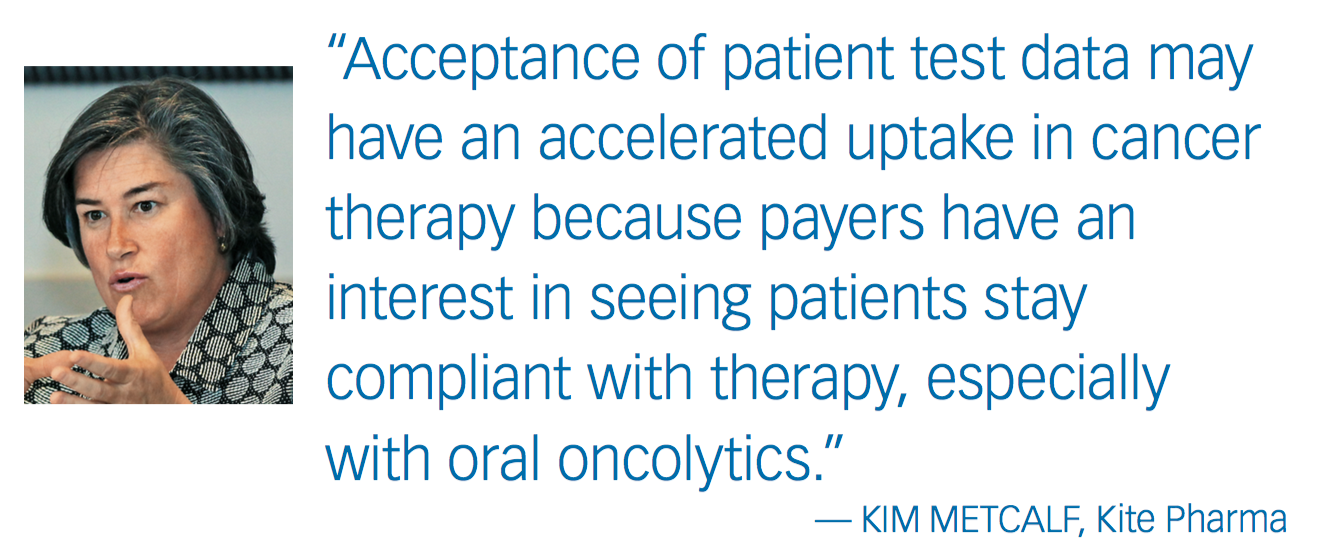
cancer therapy because payers have an interest in seeing patients stay compliant with therapy, especially with oral oncolytics. Patients taking these drugs must be satisfied because failure to complete the course of treatment bears a high probability of relapse. It relates to the larger point that more cancers are being treated as a complex chronic disease.
Looney: Survey comments opposing PROs for replacing hard metrics with anecdotal emotions suggest a slowness to adapt to changes in technology and practice that make it easier to document patient outcomes. Does this inflexibility extend to the R&D organizations of big pharma? Is there still a need for a cultural change that opens the door for endorsement of tools like the PRO? How do you break the mindset that looks at patient data as something “nice to have” but not a “have to have?”
Ramaswamy: Cultural change is ongoing. Change in biopharma has been gradual, but it is accelerating at a very rapid pace. For example, looking back five years, I cannot think of one major oncology trial at Pfizer that did not include a PRO assessment. If we can account for expected variability and have enough sample-size to make it possible to pick up clearly reportable differences between the two arms of a clinical trial, I will get assent from management to go ahead. Everything is open to consideration. Sophistication with sample-size calculation, item selection and instrument selection has improved so that we can plan better.
Regulators are becoming more accommodating, too. If I send a trial protocol for comment to the European Medicines Agency (EMA), I usually get a quick response that is often very incisive. More importantly, since the EMA now has a rule requiring input from patient advocates, its advice could actually change the way we approach the market for the compound.
What about the patient?
Looney: What does the inVentiv Health survey conclude about the appropriate role of patient advocacy groups in the development of the PRO?
White: We asked the payers how much involvement patient advocates should have in discussions about products. Overall, the response was “not much.” Again, however, pharmacy directors were more positive than the medical directors about bringing patient advocates into the fold. You will see in the comments that there is an undercurrent of bias toward these groups as being in the pocket of the drug industry, with the bigger patient groups crowding out smaller ones in getting favorable payer treatment on reimbursement coverage.
One interviewee observed that while patient advocates are irrelevant to the basic markers of clinical efficacy and safety required for registration, their input can be valuable for measures of drug tolerability, dosage formulation, and what progression-free survival really looks like from the patient point of view-and how that relates to the cost of hospice services.
Millie Webster, Agios Pharmaceuticals: It’s perverse that these payers suggest patient advocates are biased to the point that PRO data is tainted, when all the other data submitted through trials bears the imprint of the pharmaceutical
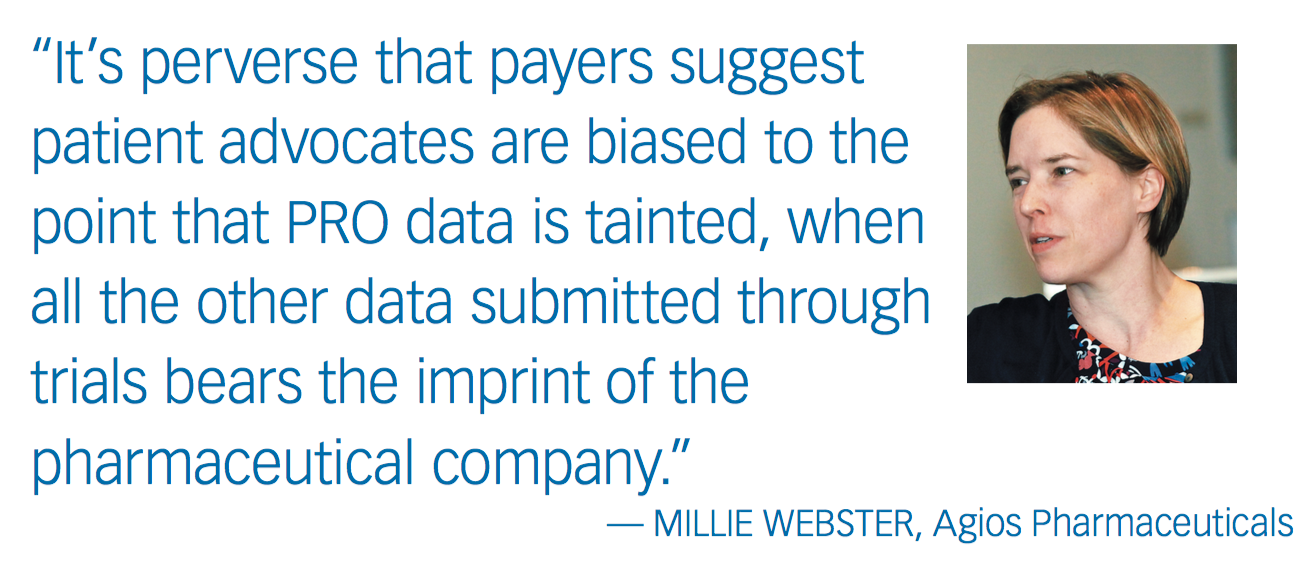
company-isn’t it in the payers’ interest to see some weight given to other perspectives that might supplement or differ from the trial sponsor company?
Patricia Goldsmith, CancerCare: These conclusions are no surprise to me. Payers often see patient groups as shills for the drug manufacturers. There is a warped sense of what advocacy actually does for patients. I know a prominent medical director for one of the largest payers in the country who expressed interest in working with CancerCare but backed out when he discovered we administer a drug co-pay support Foundation, whose work is overseen by the HHS Office of Inspector General (OIG). That says a lot on where they see their priorities. I have been invited to meet with the six largest payer groups in the country, including their medical directors on oncology, to examine ways to work together. I am hopeful that we will see progress on collaboration.
Heather Gartman, inVentiv Health: The payer perception of the relationship between patient advocates and pharma is not only outdated, it’s often outright false. As we heard, payers tell us that they see patient advocates pushing for treatment coverage as a front for pharmaceutical companies-they are being paid for that advocacy. Twenty years ago the notion of advocates being in bed with biopharma may have been more accurate, but today these groups stand on their own.
Biopharmaceutical company grants are now almost entirely unrestricted and many advocacy groups have their own established, vetted funding infrastructure. There is an opportunity and a need to educate payers about the contribution of advocates to building cost-effective healthcare solutions. Both parties should share insights and collaborate so that patients don’t become victims in the battle.
Metcalf: There is a significant degree of cost shifting going on in the market for medicines. Upwards of 50% of the cost of a medicine is actually subsidized by the drug manufacturer in the form of rebates and discounts as well as from the industry’s cash contributions to the federal government to subsidize Medicare Part D. In the oral oncolytic space, these subsidies have extended access to life-saving medicines for many thousands of people. Despite that, payers are increasing their cost-shifting efforts, this time to the patient. Not only are we seeing premium increases, we also see a fourth tier on formulary lists-the specialty drug carve-out-which requires patients to pay a 25% co-insurance rate or higher on each prescribed drug.
Goldsmith: The talk is always about the increasing cost of medicines for the payer. But the evidence shows that upwards of 70% of the insured commercial business is administering benefits funded by employer contributions. Payers are not financially liable; it’s a pass through with employers funding the expense. But the biggest issue I see is the lack of interest in collaboration to find a solution to medicines costs in oncology. Instead, you have the payers vilifying drug manufacturers, the patient trapped in the
middle, and non-profit advocacy groups trying their best to fill the gap without a sustainable funding base.
And patients don’t have time to waste on process and politics. Of the 180,000 people that we served last year, 60% of them were seeking some type of financial assistance, many relating to their hospital bills, not drugs. Their day-to-day concerns are so basic: the number one request we get is finding transportation to get from home to the clinic for chemo or clinical trial participation.
Cancer’s neglected home front
Looney: The CancerCare 2016 Patient Access and Engagement Report you cited at the outset of our discussion-what are the principal conclusions that you see as relevant to the incorporation of more patient data in cancer research and treatment?
Goldsmith: The biggest takeaway from the report is that cancer is a disease that extends beyond the individual to the family, the caregiver-and society itself. The adverse impacts are lingering; they don’t end with the conclusion of treatment. What amazes me is the disconnect between what patients tell their physicians and how physicians process that information. The gap in perceptions and understanding is very wide. Then there is the financial strain, which is manifest in pill splitting, skipping refills, importing drugs from outside the US, and forgoing basic necessities like rent and groceries to pay medical bills.
A surprising finding from the survey-we talked to over 3,000 cancer patients throughout the country-is how patients are relying more heavily on their primary care physicians. Two decades in academic medicine had convinced me that once a patient was settled with an oncologist, he or she would never go back to their GP. Why is this happening? We found that patients feel that primary care contacts offer more psychosocial support-the physician has more time than the overextended oncologist to talk and listen about symptoms and course of treatment. It’s sad, but all too real a concern. A third of our people in the survey said they had no caregiver on hand to just be there to help.
O’Connell: One conclusion I draw is patients don’t feel the things that matter to them are acknowledged in the information hierarchy that dominates clinical decisions on care and treatment. Recently, I saw a survey where patients were

asked how much progression-free survival time they would give up in return for relief from the fatigue that accompanies drug treatment, from severe to mild or moderate. The answer was they would forgo four and a half months of disease control, just to be able to function a bit better on the routines of daily life! A startling finding-on a question that probably most providers would never have asked.
Looney: It also argues that more should be done to get this kind of response into the mix when clinical trials are being designed to test new compounds for toxicity and side effects.
White: We addressed this in the survey by asking our payers whether and when patient advocacy groups should be involved in the design and execution of clinical trials. Two thirds said their inclusion at any stage would not be appropriate. Of the third who expressed support, medical directors said patients should only be engaged at Phase III, while pharmacy directors were split among all phases-II, III and also post-marketing Phase IV. Again, you detect more hesitance with the medical directors.
Ramaswamy: The science of medicine is critical but you have to acknowledge that medicine is also, in some ways, an art. The physician, the patient and the drug regimen are the three participants in the art. There is a place for the patient viewpoint at virtually every phase of the trial, and now some institutional review boards (IRBs) are actively encouraging us to do so in Phase III trials. But especially at Phase IV, I think patient input is invaluable. For example, if you are designing a Phase IV trial, you want to talk to patient advocates who could tell us why or if we need to test other treatment regimens beyond the one approved by the FDA on the basis of the RCT. You can get a better sense of the impact of dosage variations, titration cycles and duration of treatment to mitigate the impact of side effects that are only evident once the drug is in wide use.
No matter how much effort one puts into dose-ranging studies, it is a reality that we can only launch drugs at certain tolerable and effective doses. But in real-world use, with expanded access to the drug, oncologists and patients working together often figure out dosage adjustments or changes to the regimen that make a lot of sense from tolerability and effectiveness standpoints. So beyond the effort to secure FDA approval, at some point it’s good to have the practical input from patients and to do post-marketing research. That’s money well spent if it facilitates a more tolerable regimen as use of the drug is expanded in clinical practice.
Patient registries: A way forward?
Metcalf: Thinking beyond the clinical trial platform, patient registries are an emerging evidence and information tool that could incorporate PRO data very effectively. PRO could be included in the registry questionnaires, creating a richer and more robust data pool able to track the patient experience in the real-world setting. Today, patient registries are the equivalent of the clinical trial for the post-marketing phase. The difference is, in a registry, there is no requirement to prove safety and efficacy. The data can be applied to work on label updating and improving dosing and management of side effects. I see it as one solution to the question of where is the best place to put the PRO.
White: It would also address the data bias perception raised by payers in our survey.
O’Connell: Patient registries are relevant in other ways, the most important of which is the move toward conditional approvals by the regulatory authorities. The world is moving away from the narrow, sequential approach to evaluating evidence, under the traditional clinical trial model. We can expect more evidence gathered in a pattern that might take a compound from Phase 1 or IIb to conditional approval followed by full acceptance founded on results from a Phase IV study.
Gartman: Patient registries are a big part of the agenda for disease advocacy groups. We surveyed 40 patient groups and found that two-thirds either had or were launching their own registry. So a track record is in place to show how to apply this structure to the real world.
Ramaswamy: The caveat is that patient registries are not generally an accepted vehicle for the evidence to support a positive label ruling from the FDA. That is the hurdle allowing us opportunity to shape our clinical and marketing messages to physicians and patients. A strong label is the holy grail for biopharma, and indeed payers pay a lot of attention when a PRO is in the label. I think that is a limiting factor for patient registries and the substantial investments industry would have to make to put PROs into the registry database. In that regard, I see patient registries as a potentially useful source of information rather than a true game changer in putting the PRO on the map in drug development. If on the other hand, as some trends suggest, pragmatic trials and similar designs become more acceptable, PRO data from those settings can help a lot.
Metcalf: That’s a fair point. On a larger level, it’s equally true that adding more patient evidence to the evaluation mix can slow the timetable for drug approvals. For a small company, delays force the utilization of more resources. An idea that slows the track to approval, like the point made earlier about fine-tuning the dose regimen to get at observed side effects-someone must be prepared to make a decision. It’s a difficult one.
Webster: On the other hand, as cancer evolves toward more of a chronic disease that will require numerous drugs on a maintenance schedule, might this add to the interest in patient evidence that can show comparatively which drugs provides the best clinical benefit over time, promote good compliance or even just burdening patients the least?
Ramaswamy: If PRO data can relay such benefit objectively-and I think it can-with medicines or regimens that turn your cancer from something that will kill you in four months to survival of four or 10 or more years, then there is a place for it.
Next steps
Looney: What is the group consensus on key steps required to raise the profile and application of the PRO in informing a drug development process that supports patients?
Ramaswamy: What I take away from the discussion is that our industry must educate the payers on how far we have come in making patients-and PRO-part of the evidentiary process in drug development and access. Payers must know that we are serious in reaching out to our patients. The same holds true for industry
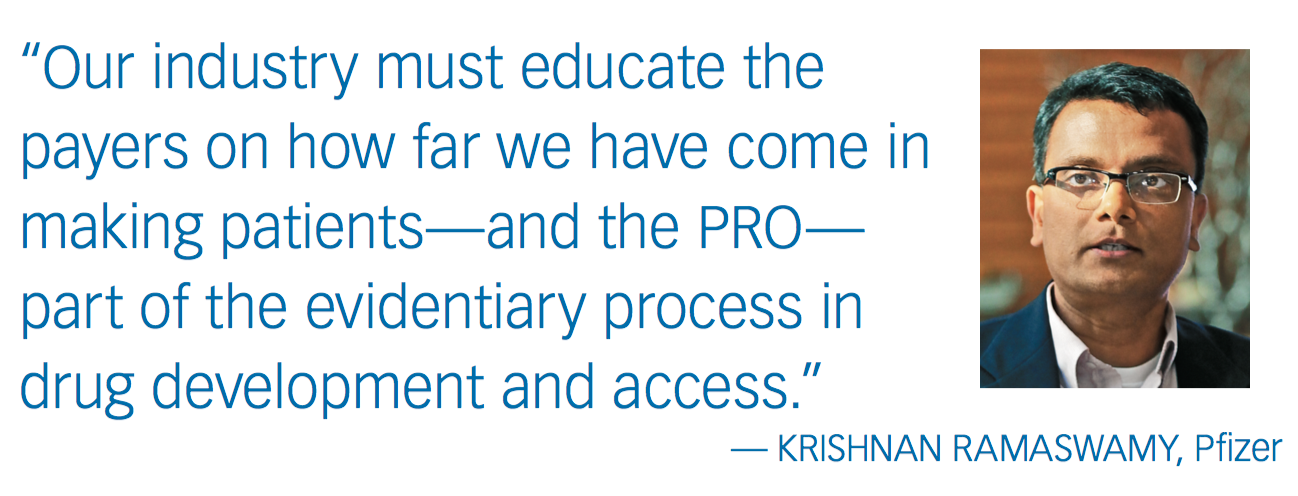
relationships with patient advocates. They should know more about the hurdles we face in obtaining approval and access to our medicines. Both of us would do well to sit down and focus squarely on what can be done to improve the conditions under which we strive to do the right thing for the patient. What will it take to move the conversation forward?
Metcalf: Not all patient experiences are subjective or unmeasurable. There are many examples we can cite to showcase progress in addressing patient interests holistically, across the entire continuum of care, that also produce great metrics in delivering increased quality at a manageable cost. One that comes to mind is the Oncology Patient-Centered Medical Home (OPMH) model led by Dr. John Sprandio of the Crozer-Keystone Health System in Pennsylvania, with support from Aetna. It is testing team-oriented case management approaches to raise the bar on interactions between patient and physician. Another is the work that Dr. Lee Newcomer of United Healthcare has done with Episodes of Care. It demonstrated how increased spending on appropriate drugs can actually lower the overall cost of cancer care.
Ramaswamy: We all know that the strength of the one-to-one physician patient relationship in oncology is a major determinant of outcomes-we just don’t have metrics that explain why. There is enormous variability in the time and effort that physicians put into their work with patients, as well as what they consider important in treatment. I’ve recently reviewed unpublished papers that reveal how the same drug can produce outcomes 30 to 40% better when the physician spends extra time to tailor the dose and the regimen, based on the individual patient’s profile. This is significant. But it runs counter to the pressures physicians face to spend as little time as possible in direct contact with the patient.
Looney: The Journal of Clinical Oncology earlier this year published a study confirming the low take up of PROs to shape the labels for oncology products. It also suggested eight steps biopharma could take to improve on this performance. Do these ideas appear realistic to you?
Metcalf: One of the interesting statistics in the study was that only 7.5% of reported trials from 2010 to 2014 had a PRO, while 24% of trials from 2006 to 2010 had a PRO. The FDA Guidance on PRO data was issued at the midpoint of the time studied. It raises a question: has the guidance discouraged new applicants from including a PRO to back up the labeling claim?
Ramaswamy: In my experience, the guidance has actually encouraged inclusion of the PRO by helping create clear expectations. What has happened is that with the effort to make clarifications, standards of review are more rigorous-the FDA, for instance, is tougher in the way they screen and dissect the PRO data. Also, smaller, Phase II trials are not ideal for getting conclusive evidence on PROs, so that may be a factor as well.
O’Connell: The Journal of Clinical Oncology piece also did not address the arrival of technologies that offer new, more objective ways to measure how patients function under a particular therapy. A Fitbit wrist can measure whether a patient can get up and walk across a room, which serves as an indicator of fatigue. But whether this is accepted as an objective source of data is, again, still open to interpretation.
Webster: These are imperfect measures, but I see a willingness from the FDA and other stakeholders to engage patient advocates in testing other, similar approaches beyond the PRO. The ePRO is one example.
Ramaswamy: ePROs are helpful if the objective is to take measures of symptoms or patient satisfaction more frequently. The ePRO is definitely more useful than the patient diary as a recorder of thoughts and actions-a couple of phone dings and the patient inputs a response, in real time. That has to be valuable on its face. One has to balance not burdening the patient by making this intrusive, of course.
Millham: It also carries an advantage in that such data may be able to be collected at home rather than in the institutional setting. The downside is that ePROs often require investment in different data collection devices; the cost of shipping and retrieving them is not inconsiderable. There are low-cost options building on existing technologies, like the smart phone app. Patients may have access to these already.
Ramaswamy: One trend I see as interesting is the increased meaningfulness-the quality and thought-that is coming from patient responses to data requests. You see a lot more individual variations, as opposed to patients coming at you in undifferentiated clusters. It might have something to do with the intimacy of the connections offered by new communications technology.
White: It is also due to healthcare being much less paternalistic. There is a generational aspect. Younger patients are less willing to be dictated to; they are more open. In the past, a patient would nod dutifully to the attending oncologist and say she was fine. Today, the patient will likely give the physician all the detail on just how hard it was to make it from the bedroom to the kitchen.
Looney: It’s fair to conclude that payers, providers, and the industry are being gifted with an abundance of data. The challenge is to leverage this abundance to better interpret-and ultimately improve-the institutional response to an evident escalation on patient need.
O’Connell: As a representative of a key service provider in oncology drug development, I emphasize the importance of raising the visibility and relevance of PRO, both in cancer research and in the clinical setting. There are many stakeholders with distinct perspectives but ultimately the medicines society relies on to fight cancer are in the hands of busy providers, who give them to real patients. We all must act to make that process as informed and seamless as possible.
William Looney is Pharm Exec’s Editor-in-Chief. He can be reached at william.looney@ubm.com
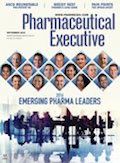
Addressing Disparities in Psoriasis Trials: Takeda's Strategies for Inclusivity in Clinical Research
April 14th 2025LaShell Robinson, Head of Global Feasibility and Trial Equity at Takeda, speaks about the company's strategies to engage patients in underrepresented populations in its phase III psoriasis trials.
Bristol Myers Squibb’s Cobenfy Falls Short in Phase III Trial as Add On Therapy for Schizophrenia
April 23rd 2025In the Phase III ARISE trial, Cobenfy administered as an adjunctive treatment to atypical antipsychotics for patients with inadequately controlled schizophrenia did not achieve statistically significant improvements.
Key Findings of the NIAGARA and HIMALAYA Trials
November 8th 2024In this episode of the Pharmaceutical Executive podcast, Shubh Goel, head of immuno-oncology, gastrointestinal tumors, US oncology business unit, AstraZeneca, discusses the findings of the NIAGARA trial in bladder cancer and the significance of the five-year overall survival data from the HIMALAYA trial, particularly the long-term efficacy of the STRIDE regimen for unresectable liver cancer.
Expanding Immune Response Testing to Support Vaccine Development
April 22nd 2025Nigel McCracken, chief operating officer, Virax Biolabs, discusses the expansion of its ViraxImmune platform into areas such as transplant monitoring, vaccine efficacy, latent virus reactivation, and CAR T cell therapy.